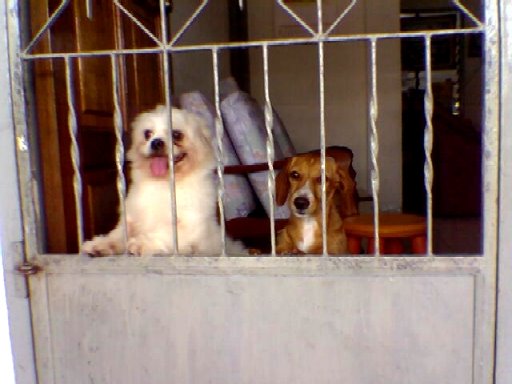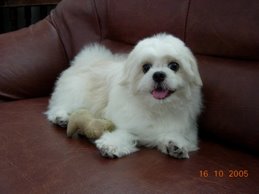Article From SubmitYOURArticle.com: Siberian Husky Dog Breed Profile
Description: The Siberian Husky is a well
muscled, medium sized dog. The dog will be
between 21 to 23 inches at the shoulder, with the
bitch an inch less. This dog weighs between 45
and 60 pounds for the male and 35 to 50 for the
female. The Husky has a very thick double coat of
medium length, which protects it from cold. The
most common coat colors are black and white, grey
and white, white, reddish and white, and silver.
The ears are erect and furry. The eyes of the
Siberian husky can be bi-eyed, where one eye is
blue and the other brown, or parti-eyed, where
each eye is half blue and half brown. This dog
has an average life span of 12 to 15 years. It is
also called Sibe or Husky.
History: For hundreds of years, the Siberian
Husky was a working dog for the Chukchi tribe of
Siberia. Fur traders were responsible for
bringing the Siberian Husky to Alaska to
participate in sled dog races. The Siberian Husky
gained fame during a terrible diphtheria outbreak
in 1908. As this occurred during the winter and
access to remote villages was nearly difficult,
the Siberian Husky was used to take medicine to
afflicted populations. This dog was used by
Admiral Byrd in his explorations in Antarctica.
Temperament: The Siberian Husky is a dog that
enjoys being around its human family as much as
possible. It is a gentle dog, but has in
independent outlook on life. They are friendly
and relaxed and wants to interact with its family
as much as possible. This dog has a very strong
hunting instinct, so care should be taken with
cats and other small household pets. As the Husky
is a dog that loves to be active, it can become
destructive if it becomes bored through
inactivity. It is often suggested that keeping
two of these dogs will prevent this negative
behavior.
Health Issues: The Siberian Husky is basically a
tough, healthy dog, but can be subject to several
health problems. The most common concerns the
eyes, where the dog can develop cataracts or
progressive retinal atrophy (which will
eventually lead to blindness). Dogs used in sled
racing can become ill with bronchitis.
Fortunately, hip dysplasia is relatively rare in
this breed.
Grooming: The Siberian Husky sheds heavily, so
some attention should be paid to grooming this
dog. It should be brushed twice a week year
round, but every day when it molts its coat twice
during the year. Extra care should be given to
the feet if the dog is used for sled racing, to
make sure there is no build up of ice between the
toes.
Living Conditions: The Siberian Husky is most
comfortable living in a cooler climate. This dog
is devoted to its human family and will be happy
living indoors as long as its need for exercise
is met. It is especially suitable for families
that enjoy taking part in outdoor winter
activities. The Husky can easily live outdoors in
the most rigorous climate, being able to tolerate
temperatures of -76F.
----------------------------------------------------
For more information on the Siberian Husky,
Training and Puppies for sale visit the page
below.
http://www.scottspuppypalace.com
EasyPublish this article: http://submityourarticle.com/articles/easypublish.php?art_id=87219














.jpg)






.jpg)

0 comments:
Post a Comment